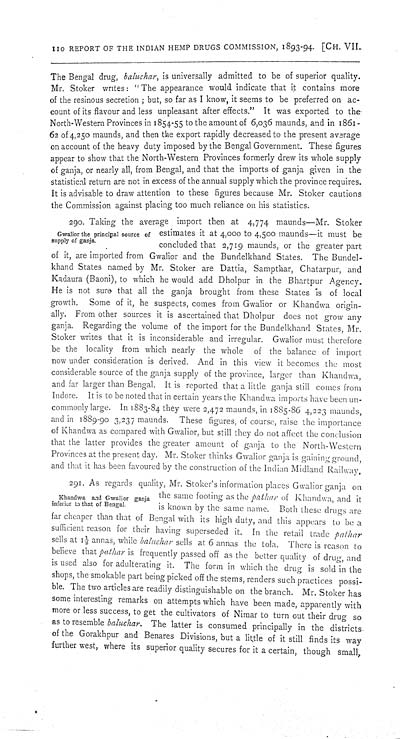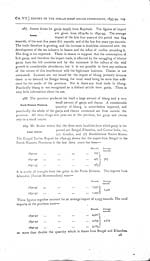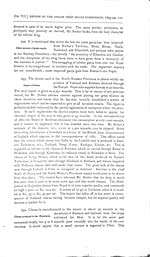Medicine - Drugs > Report of the Indian Hemp Drugs Commission, 1894-1895 > Volume I
(138) Page 110
Download files
Individual page:
Thumbnail gallery: Grid view | List view

110 REPORT OF THE INDIAN HEMP DRUGS COMMISSION, 1893-94. [CH. VII.
The Bengal drug,
baluchar, is universally admitted to be of superior
quality.
Mr. Stoker writes: "The appearance would indicate that it contains
more
of the resinous secretion; but, so far as I know, it seems to be
preferred on ac-
count of its flavour and less unpleasant after effects." It was
exported to the
North-Western Provinces in 1854-55 to the amount of 6,036 maunds,
and in 1861—
62 of 4,250 maunds, and then the export rapidly decreased to the
present average
on account of the heavy duty imposed by the Bengal Government.
These figures
appear to show that the North-Western Provinces formerly drew its
whole supply
of ganja, or nearly all, from Bengal, and that the imports of ganja
given in the
statistical return are not in excess of the annual supply which the
province requires.
It is advisable to draw attention to these figures because Mr.
Stoker cautions
the Commission against placing too much reliance on his
statistics.
Gwalior the principal
source of
supply of ganja.
290. Taking the average
import then at 4,774 maunds—Mr.
Stoker
estimates it at 4,000 to
4,500 maunds—it must be
concluded that 2,719 maunds, or the greater part
of it, are imported from
Gwalior and the Bundelkhand States. The Bundel-
khand States named by Mr. Stoker are Dattia, Sampthar, Chatarpur,
and
Kadaura (Baoni), to which he would add Dholpur in the Bhartpur
Agency.
He is not sure that all the ganja brought from these States is of
local
growth. Some of it, he suspects, comes from Gwalior or Khandwa
origin-
ally. From other sources it is ascertained that Dholpur does not
grow any
ganja. Regarding the volume of the import for the Bundelkhand
States, Mr.
Stoker writes that it is inconsiderable and irregular. Gwalior must
therefore
be the locality from which nearly the whole of the balance of
import
now under consideration is derived. And in this view it becomes the
most
considerable source of the ganja supply of the province, larger
than Khandwa,
and far larger than Bengal. It is reported that a little ganja
still comes from
Indore. It is to be noted that in certain years the Khandwa imports
have been un-
commonly large. In 1883-84 they were 2,472 maunds, in 1885-86 4,223
maunds,
and in 1889-90 3,237 maunds. These figures, of course, raise the
importance
of Khandwa as compared with Gwalior, but still they do not affect
the conclusion
that the latter provides the greater amount of ganja to the
North-Western
Provinces at the present day. Mr. Stoker thinks Gwalior ganja is
gaining ground,
and that it has been favoured by the construction of the Indian
Midland Railway.
Khandwa and Gwalior
ganja
inferior to that of Bengal.
291. As regards quality,
Mr. Stoker's information places Gwalior ganja on
the same footing as the
pathar of Khandwa, and it
is known by the same name. Both these drugs are
far cheaper than that of
Bengal with its high duty, and this appears to be a
sufficient reason for their having superseded it. In the retail
trade pathar
sells at 1½ annas, while baluchar
sells at 6 annas the tola. There is reason to
believe that pathar is frequently passed off as the better
quality of drug, and
is used also for adulterating it. The form in which the drug is
sold in the
shops, the smokable part being picked off the stems, renders such
practices possi-
ble. The two articles are readily distinguishable on the branch.
Mr. Stoker has
some interesting remarks on attempts which have been made,
apparently with
more or less success, to get the cultivators of Nimar to turn out
their drug so
as to resemble baluchar. The latter is consumed principally
in the districts
of the Gorakhpur and Benares Divisions, but a little of it still
finds its way
further west, where its superior quality secures for it a certain,
though small,
Set display mode to: Large image | Zoom image | Transcription
Images and transcriptions on this page, including medium image downloads, may be used under the Creative Commons Attribution 4.0 International Licence unless otherwise stated. ![]()
| India Papers > Medicine - Drugs > Report of the Indian Hemp Drugs Commission, 1894-1895 > Volume I > (138) Page 110 |
|---|
| Permanent URL | https://digital.nls.uk/74574342 |
|---|---|
| Description | Chapter VII, cont. |
| Description | [Volume 1]: Report. |
|---|---|
| Attribution and copyright: |
|




